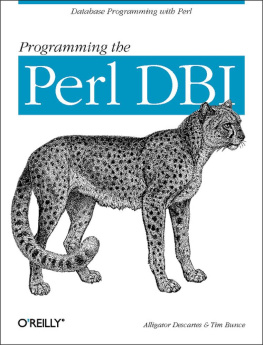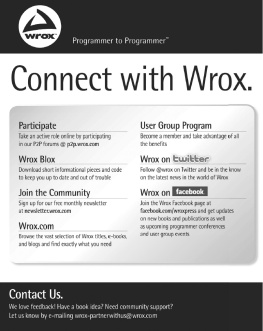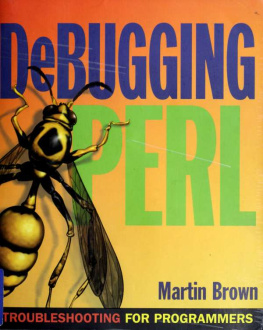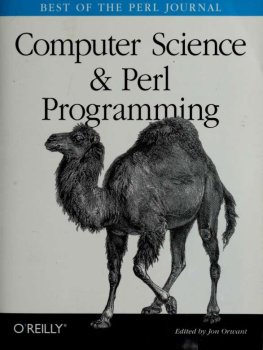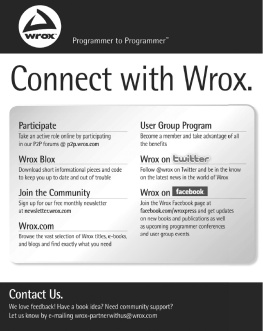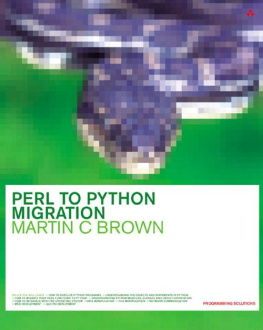Contents
Introduction...................................................................... xix
CHAPTER 2
Summary...................................................... 47
CHAPTER 3
Summary...................................................... 86
Retrieving a Web Page...................................... 97
Submitting a Web Form.................................... 100
Handling Password-Protected Sites.......................... 101
Mirroring a Web Site....................................... 102
Summary..................................................... 105
Summary..................................................... 133
Summary..................................................... 152
CHAPTER 8
Summary..................................................... 163
Summary..................................................... 180
Summary..................................................... 200
Summary..................................................... 230
.................................. 235
Variables................................................. 244
Summary..................................................... 262
Request Objects........................................... 276
Summary..................................................... 281
Introduction
T his is a book about Perl, the programming language. More specifically, this is a book about some aspects of Perl interacting with the Internet. The book includes coverage of CGI through the Perl CGI.pm module, as well as much additional information. Youll explore such topics as how to send e-mail from a Perl program through Net::SMTP, how to use Net::DNS, and even how to use Net::Ping. Youll learn how to build a templated web site two different ways, one with the help of HTML::Mason and the other with the Template Toolkit. Youll learn how to consume SOAP web services, how to read and write RSS, and how to work with XML, all through Perl.
What This Book Covers
This book attempts to give readers who have learned some Perl a grasp of the concepts and considerations for programming for the Web or creating a Perl program that interacts with the network. This book is fairly Linux-centric. Thats not to say that these programs wont run on a Windows platformthey will, with very little tweaking.
The book is divided into five parts. The first part covers what comes to mind for many people when they think of Perl and web developmentnamely, CGI development and database interaction. The CGI module is examined, and I present tips for programming CGIs, such as the Carp module for debugging. The second part of the book widens the focus into Internet interaction with Perl. The Net:: family of modules is covered, along with the LWP for retrieving web pages through Perl. Coverage of XML and RSS make up the third part of the book, where youll learn about XML parsing through Perl, consumption of SOAP web services, and RSS feeds. The fourth part of the book looks at mod_perl for development. The fifth and final part of the book examines templating through the Template Toolkit and HTML::Mason.
What You Should Know
To use this book successfully, youll need to know about Perl basics such as scalar variables, arrays, and hashes; the use of control structures such as if/else, for, and while; and other topics such as those youd find in a book like Beginning Perl, Second Edition (Apress, 2004). Essentially, you should be comfortable with Perl before reading this book. You should also know how to install Perl modules, whether through your distributions mechanism, such as apt for Debian, or through the use of CPAN. The books appendix is an excerpt from the aforementioned Beginning Perl title. If you havent used Perl in a while, the appendix can provide a good refresher into the language, but youll find that reading the entire Beginning Perl book will be helpful to pick up where the appendix leaves off.
INTRODUCTION
This book will use Perl on a Linux system. The exact flavor of Linux isnt important, though I likely have some references to Debian. Perl being Perl means that the programs will run successfully with little modification on any system that can run Apache, including Microsoft Windows.
Why Apache?
Simply put, Apache works. Apache is overwhelmingly the most popular web server in use on the Internet, according to the Netcraft survey (http://news.netcraft.com/archives/ web_server_survey.html). Apache is open source and configurable for just about any need. Apache is stable and predictable, even under heavy load. Apache is robust, serving web without using too many resources, and its able to use resources effectively to serve heavy traffic loads.
This is not to say that Microsofts IIS hasnt made good strides toward meeting its competition in Apache. IIS has indeed improved its stability with version 6, but with the benchmark being IIS 5 and its predecessors, it didnt take much to improve on the stability. However, IIS is still not as good as Apache at serving web and has a long way to go before getting there.
P A R T 1
CGI Development with Perl
CHAPTER 1
The CGI Module
T he CGI module is central to web development with Perl. In fact, the CGI module is as far as some people go with Perl web development. However, theres more to Perl for the Web than just CGI. You have endless ways to interact with the Internet from a Perl program. This book will show you many of those methods. Even so, the CGI module is a good place to start.
In this chapter, youll learn the basics of Perl-based CGI application development, including how to use both the function-oriented and object-oriented styles, some of the functions offered by the CGI module, how to use environment variables, tips for debugging and troubleshooting CGI applications, and the all-important security considerations. Lets begin with an introduction to CGI.
An Overview of CGI
CGI, or Common Gateway Interface, is a standard of communication between a web server and a client, such as a user with a web browser. Over time, CGI has come to refer to a class of programs that work with web servers. The programs themselves are considered to be external or separate from the web servers, but they provide a gateway between the client and server thus the Gateway portion of the name Common Gateway Interface.
CGI is a standard unto itself. The current standard provides a common interface, which means that CGI programs can be written in a number of languages. Of the languages with which a CGI program can be written, Perl is arguably the most common.
Perl provides an easy-to-use syntax with a gently sloped learning curve. Yet Perl, along with its myriad modules, is incredibly powerful and robust. The Apache web server, which is usually run on Unix/Linux, continues to hold the dominant market share over all web servers on the Internet. Perl is also very common on these same Unix/Linux systems. Being available and powerful leads to the ubiquity of Perl for CGI development.
Note If youre unfamiliar with Perl, please flip to this books appendix for an overview of the language. In
that appendix, youll find excerpts from Beginning Perl,Second Edition by James Lee (Apress, 2004). I recommend picking up a copy of Beginning Perl for a full introduction to the language.
1. The surveys conducted by Netcraft (http://news.netcraft.com/archives/web_server_survey.html) confirm this fact.
For quite a long time (in Internet time), CGIs were frequently developed with help from a library called cgi-lib.pl. The CGI library, or cgi-lib, was a function-oriented way to simplify development of CGI programs in Perl. A developer could use the common functions of the library, rather than needing to rewrite those functions from scratch. The cgi-lib also enabled developers with less experience to write very powerful applications to interact with the Web.



